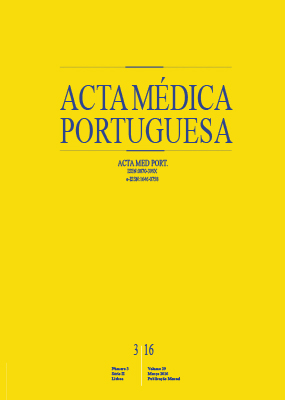Autism and Early Neurodevelopmental Milestones
DOI:
https://doi.org/10.20344/amp.6790Keywords:
Autistic Disorder, Child Development, Developmental Disabilities, Prognosis.Abstract
Introduction: Autism spectrum disorder, also referred to in this study as autism, is a neurodevelopmental chronic disease that manifests early in childhood by impairment in social interaction, communication and repetitive behavior. Since there are no specific biomarkers available, the diagnosis is based exclusively on clinical criteria. The purpose of the present study is to determine which are the early psychomotor development or neurodevelopmental milestones that present a significant correlation with the severity of the main symptoms of autism, development quotients, and adaptive function.
Material and Methods: We performed a retrospective study on a sample of 1572 individuals with a diagnosis of autism that were monitored at Hospital Pediátrico do Centro Hospitalar e Universitário de Coimbra, in the Neurodevelopment and Autism Unit. We analyzed six early psychomotor developmental milestones: age of acquisition of ‘walking’, ‘first words’, ‘first phrases’, ‘daytime control of bladder sphincter’, ‘night-time control of bladder sphincter’, and age of first complaints. Afterwards, we divided the sample in three subgroups regarding clinical severity, according to the Childhood Autism Rating Scale, and we analyzed significant differences among each other concerning the six milestones established beforehand.
Results: The milestone ‘age of first phrases’ was, from the six milestones, the one with a stronger correlation with the variables of clinical manifestations of autism, development/intelligence quotients, and adaptive function. In division of the sample into subgroups of clinical severity, it was the most severe that showed later ages of acquisition of the neurodevelopmental milestones and earlier ages of first complaints.
Discussion: This study proves the clinical utility to know the age of achievement of early psychomotor developmental skills, since they act as predictors of clinical severity of autism, cognition, and adaptive function of a wide population with autism. Therefore, this data contribute for prognostic and prediction of autism progression.
Conclusion: Taking into account the results of this study, it is strongly recommended to all clinicians who have contact with autistic children, to record the ´age of acquisition of first phrases´.
Downloads
Downloads
Published
How to Cite
Issue
Section
License
All the articles published in the AMP are open access and comply with the requirements of funding agencies or academic institutions. The AMP is governed by the terms of the Creative Commons ‘Attribution – Non-Commercial Use - (CC-BY-NC)’ license, regarding the use by third parties.
It is the author’s responsibility to obtain approval for the reproduction of figures, tables, etc. from other publications.
Upon acceptance of an article for publication, the authors will be asked to complete the ICMJE “Copyright Liability and Copyright Sharing Statement “(http://www.actamedicaportuguesa.com/info/AMP-NormasPublicacao.pdf) and the “Declaration of Potential Conflicts of Interest” (http:// www.icmje.org/conflicts-of-interest). An e-mail will be sent to the corresponding author to acknowledge receipt of the manuscript.
After publication, the authors are authorised to make their articles available in repositories of their institutions of origin, as long as they always mention where they were published and according to the Creative Commons license.









